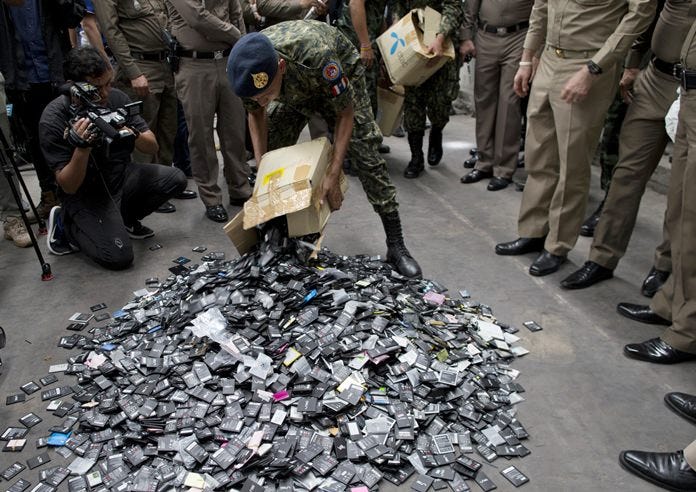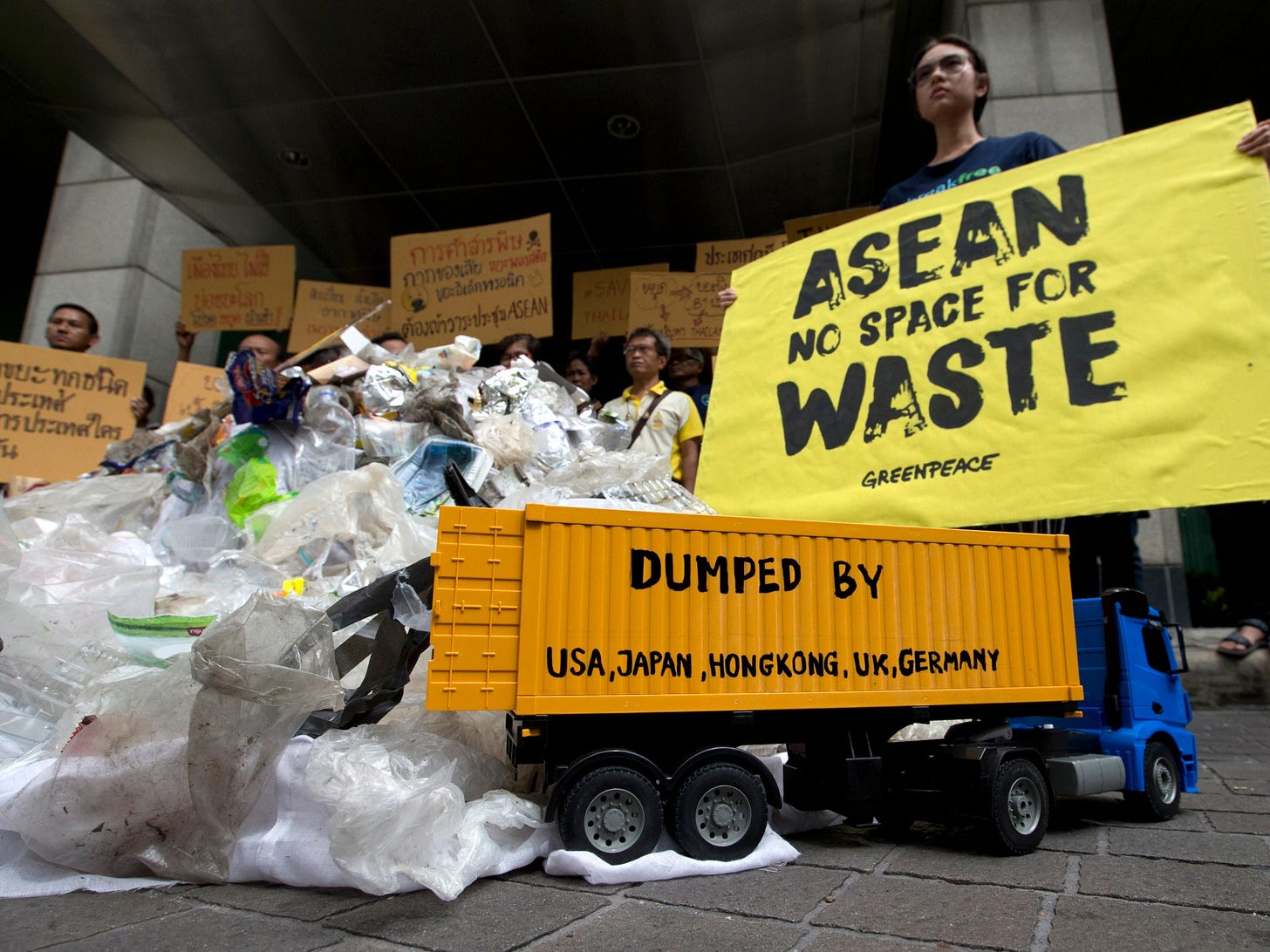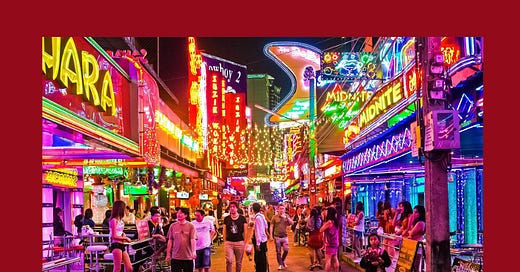Deep dive: Thailand's circular economy journey
The messy journey of turning trash into Thai treasures

Hey there! Mutiara here again with another country-by-country deep dive for circular economy analysis.
After Vietnam, let's travel a little bit West to the country with the greatest holiday destination, in my very personal opinion: Thailand. 🇹🇭🙌
And a bit of a spoiler, let's just say that Thailand's gorgeous landscapes are dealing with an unwanted accessory: mountains of waste that threaten to overshadow its natural beauty.
But here's the exciting part. Rather than accepting this as the status quo, Thailand is reimagining its entire economic model.
💡 Interesting take from Thailand: Their Bio-Circular-Green Economy Model aims to generate 4% of GDP ($23.1 billion) from circular practices by 2026—an ambitious leap to place Thailand at the frontrunner, transforming everything from rice husks to plastic waste into economic opportunity.
Thailand's current waste challenges
Thailand faces great waste management challenges, worsened by urbanisation, tourism, and inadequate infrastructure.
🗑️ Daily waste generation: Thailand produces approximately 68,400 tonnes of solid waste daily, with Bangkok alone generating 9,200 tonnes per day in fiscal 2024.
♨️ Landfill overload: Of Thailand's 2,500 dump sites, only about 20% are properly managed, leading to widespread environmental contamination.
🏙️ Urban-rural divide: Urban areas fare better in waste collection and treatment, but rural communities often lack access to adequate waste management systems.
🍱 Food waste crisis: Food waste constitutes 49% of Bangkok’s daily garbage and totals 9.7 million tonnes annually nationwide, equivalent to 146 kg per person per year.
📦 Plastic waste problem: Thailand generates between 2–2.5 million tonnes of plastic waste annually, with only 33% recycled. Plastic waste imports were banned in January 2025 due to environmental concerns.
🌊 Marine pollution: Plastic packaging accounts for 65.3% of waste collected from natural environments, contributing significantly to marine pollution.
⚠️ Illegal dumping and hazardous waste: Thailand has become a hub for illegal dumping networks and hazardous waste recycling operations, especially after China’s 2017 ban. Unlicensed factories smuggle toxic materials like e-waste into the country, with imports of e-waste rising from 2,800 metric tonnes in 2017 to 58,900 metric tons in 2023 (that's a 2,000% jump!).
👉 Also check out our deep dive on e-waste issues across Southeast Asia.

Infrastructure & societal challenges
Only 49% of municipal solid waste is properly disposed of or recycled, far below the government’s target of 75% by 2021.
Bangkok has implemented debris traps in canals, collecting up to 700 kg of waste daily, but illegal dumping remains a major issue.
Sorting at the household waste level is still a challenge as most people are still figuring out that proper sorting makes the whole system work better.
Thailand's all-in bet on circular economy
With all the waste issues that Thailand faces, the government is boldly committed to a complete economic transformation with its Bio-Circular-Green (BCG) Economy Model.
Bio-Circular-Green (BCG) Economy Model
Thailand’s BCG model integrates sustainability into core economic sectors:
🌱 Sector Focus:
Agriculture & food: Upcycling rice husks into bioenergy and converting cassava waste into biodegradable plastics.
Wellness & medicine: Developing herbal products and traditional medicine using sustainable practices.
Energy & biochemicals: Promoting biofuels and green hydrogen production.
Tourism: Certifying eco-resorts and promoting community-based tourism.
🎯 Targets:
Generate 4% of GDP ($23.1 billion) by 2026 through circular practices.
Create 3.5 million jobs in BCG sectors by 2026.
Align with UN SDGs and Thailand’s Sufficiency Economy Philosophy.
🔧 Implementation:
Quadruple helix approach (government, private sector, academia, civil society) for R&D and scaling
THB 1.2 billion ($34 million) allocated for bio-innovation hubs in Chiang Mai and Khon Kaen
Sources: Bio-Circular-Green Economy Plan
These are all not a modest goal—that's economic bungee jumping with vision.
Their Plastic Waste Management Roadmap has serious teeth too. It's phasing out single-use plastics entirely by 2030.
Plastic Waste Management Roadmap (2018–2030)
🚫 Bans:
2019: Cap seals, oxo-degradable plastics, microbeads.
2022: Foam food containers, plastic bags <36 microns, straws, single-use cups.
2025: Full prohibition on plastic waste imports.
♻️ Recycling Targets:
100% recycling of target plastics (PET, HDPE, LDPE) by 2027.
Reduce plastic waste by 0.78 million tons/year and cut CO₂ emissions by 1.2 million tons/year.
🛠️ Measures:
Extended Producer Responsibility (EPR): *Mandatory* for packaging producers from 2026.
THB 3.9 billion/year ($111 million) saved in waste management costs through improved recycling
Sources: Thailand's Roadmap on Plastic Management
All these plans that Thailand has now are a part of their National Climate Action Alignment, integrating with broader climate goals and complementing their carbon tax mechanism starting in 2025.
Everything is designed to shift behaviour while carefully avoiding consumer price shocks.
“It's about restructuring excise taxes to align with sustainability goals."
They're changing the rules of the economy to favour circular solutions.
Power in the people driving change

While the government crafts policies, Thai citizens are taking matters into their own hands with genuine passion and creativity.
Over 70 NGOs and community groups successfully advocated against what they called "waste colonialism"—the practice of wealthier countries shipping their refuse to Thailand.
Their activism worked, with Thailand now phasing out all plastic waste imports by 2025.
Meanwhile, grassroots initiatives like "Recycle for Life" aren't waiting for perfect systems.
They've already collected 45 metric tonnes of packaging waste and turned environmental action into economic opportunity through carbon credits.
From waste to wonder in economics term

Thailand's 500+ billion baht economy is discovering something fascinating: yesterday's waste streams are tomorrow's resources.
The waste management market is growing at 6.78% annually and heading toward $3.07 billion by 2030.
Tourism operators (representing 12% of GDP) realise that environmental protection isn't just good ethics—it's good business. Phuket is investing $1.1 million in new sorting facilities to protect the pristine environments that attract visitors in the first place.
Manufacturing is getting wonderfully creative. Companies are transforming rice husks into textiles, plastic waste into construction materials, and food scraps into energy.
SCG Chemicals is recycling thousands of tonnes of plastic annually—not just because it feels good, but because it makes financial sense.
The path forward
Thailand's circular journey combines ambition, creativity, and necessity.
It's like they collectively decided to reinvent their economy before the old one creates problems they can't solve.
The coming years will reveal whether Thailand can turn its circular vision into reality.
But one thing's clear—Thailand is approaching the challenge with dedication and innovation that deserves both recognition and support 👏.
Stay tuned for more thoughtful analyses of Southeast Asian circular economies in the coming weeks!
—SEArcularity




Nice post